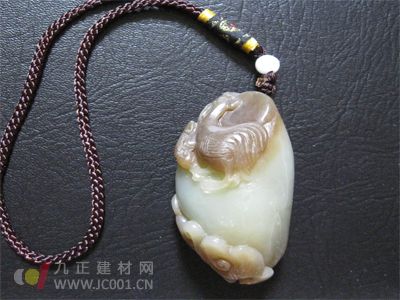Identification Method of Hetian Jade Pendant:
First, Color
Hetian jade is known for its natural and unique color, which makes it one of the most cherished treasures in the world. For collectors, color plays a key role in both evaluating quality and classifying different types of Hetian jade. The color of Hetian jade stands out among other jades, with four primary colors: white, blue-green, yellow, and black, along with various transitional shades like gray or pink. Among these, the famous "fat-white" variety is particularly rare and highly valued. This specific shade is unique to Hetian jade and adds to its exclusivity.
In addition to the main body color, Hetian jade often has skin colors that enhance its beauty. These include autumn pear skin, tiger skin, jujube skin, and black skin, each giving the jade a distinct appearance. These skin patterns are not only visually appealing but also contribute to the value of the piece, making it more desirable in the market.

Second, Hardness
Hardness is an essential factor in identifying Hetian jade. It refers to the ability of the mineral to resist scratching. There are two common ways to measure hardness: relative (Mohs scale) and absolute (indentation hardness). Hetian jade typically has a Mohs hardness of around 6.5, which places it between softer stones and harder gems. In the jewelry industry, gemstones usually have a hardness above 7 on the Mohs scale, while jade falls within the range of 4 to 7. Higher hardness means better polishability, resulting in a brighter and more durable finish.
Third, Toughness
Toughness measures how well a material resists breaking or wearing down. Unlike hardness, which focuses on resistance to scratches, toughness relates to impact resistance. Hetian jade is known for its high toughness, even compared to other jades. This makes it ideal for intricate carving and detailed craftsmanship. For instance, Hetian jade can withstand fine work without cracking or breaking easily, which is why it's often used for high-quality jewelry and decorative pieces.
Fourth, Transparency
Transparency refers to how much light can pass through the jade. It’s closely related to how the jade absorbs light. In the jade industry, terms like “water head†or “land spirit†are used to describe the clarity of the stone. A transparent jade allows clear visibility through it, while a non-transparent one blocks light completely. Hetian jade is typically micro-translucent, meaning it lets some light through but doesn’t allow clear images to be seen. This characteristic gives it a soft and elegant appearance.
Fifth, Luster
Luster is the way jade reflects light. Hetian jade has a distinctive oily luster, often described as "warm and vibrant" by ancient Chinese scholars. This luster feels smooth and moisturizing, offering a comfortable visual and tactile experience. It’s neither too shiny like crystal nor too dull like wax, creating a balanced and pleasant look that many find appealing.
Sixth, Weight
The weight of Hetian jade varies depending on its type. Its density ranges from 2.66 to 2.976 g/cm³. White jade tends to be slightly lighter than green or blue-white varieties, due to the presence of graphite inclusions. This variation in weight can help identify the type of jade and add to its overall value.
If the texture of Hetian jade is beautiful and the craftsmanship is exquisite, its value is undoubtedly high. However, such quality comes at a price, and genuine Hetian jade is always worth the investment.
Proper valves plus control actuators can make flow control in different purpose, for example shut-off valves; safety relief valves, etc. The function is a clear way to select valves efficiently. Here we go.
Valve functions, Main Functions of Valves, Functions For Valve Selections
Zhejiang Philic Fluid Control Co.,LTD , https://www.philicflow.com